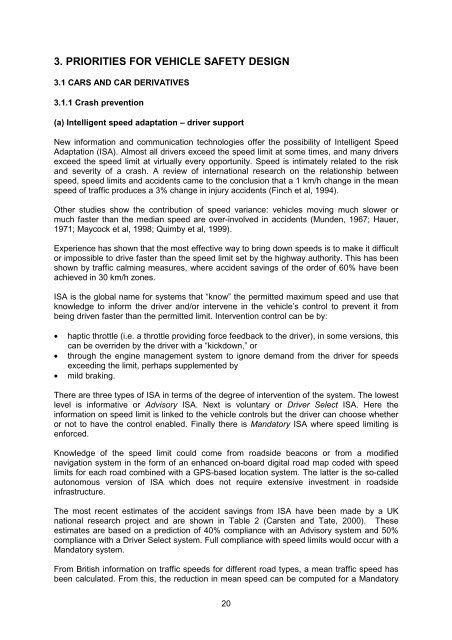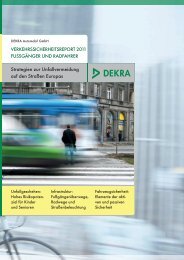PRIORITIES FOR EU MOTOR VEHICLE SAFETY DESIGN
priorities for eu motor vehicle safety design - ETSC
priorities for eu motor vehicle safety design - ETSC
You also want an ePaper? Increase the reach of your titles
YUMPU automatically turns print PDFs into web optimized ePapers that Google loves.
3. <strong>PRIORITIES</strong> <strong>FOR</strong> <strong>VEHICLE</strong> <strong>SAFETY</strong> <strong>DESIGN</strong><br />
3.1 CARS AND CAR DERIVATIVES<br />
3.1.1 Crash prevention<br />
(a) Intelligent speed adaptation – driver support<br />
New information and communication technologies offer the possibility of Intelligent Speed<br />
Adaptation (ISA). Almost all drivers exceed the speed limit at some times, and many drivers<br />
exceed the speed limit at virtually every opportunity. Speed is intimately related to the risk<br />
and severity of a crash. A review of international research on the relationship between<br />
speed, speed limits and accidents came to the conclusion that a 1 km/h change in the mean<br />
speed of traffic produces a 3% change in injury accidents (Finch et al, 1994).<br />
Other studies show the contribution of speed variance: vehicles moving much slower or<br />
much faster than the median speed are over-involved in accidents (Munden, 1967; Hauer,<br />
1971; Maycock et al, 1998; Quimby et al, 1999).<br />
Experience has shown that the most effective way to bring down speeds is to make it difficult<br />
or impossible to drive faster than the speed limit set by the highway authority. This has been<br />
shown by traffic calming measures, where accident savings of the order of 60% have been<br />
achieved in 30 km/h zones.<br />
ISA is the global name for systems that “know” the permitted maximum speed and use that<br />
knowledge to inform the driver and/or intervene in the vehicle’s control to prevent it from<br />
being driven faster than the permitted limit. Intervention control can be by:<br />
• haptic throttle (i.e. a throttle providing force feedback to the driver), in some versions, this<br />
can be overriden by the driver with a “kickdown,” or<br />
• through the engine management system to ignore demand from the driver for speeds<br />
exceeding the limit, perhaps supplemented by<br />
• mild braking.<br />
There are three types of ISA in terms of the degree of intervention of the system. The lowest<br />
level is informative or Advisory ISA. Next is voluntary or Driver Select ISA. Here the<br />
information on speed limit is linked to the vehicle controls but the driver can choose whether<br />
or not to have the control enabled. Finally there is Mandatory ISA where speed limiting is<br />
enforced.<br />
Knowledge of the speed limit could come from roadside beacons or from a modified<br />
navigation system in the form of an enhanced on-board digital road map coded with speed<br />
limits for each road combined with a GPS-based location system. The latter is the so-called<br />
autonomous version of ISA which does not require extensive investment in roadside<br />
infrastructure.<br />
The most recent estimates of the accident savings from ISA have been made by a UK<br />
national research project and are shown in Table 2 (Carsten and Tate, 2000). These<br />
estimates are based on a prediction of 40% compliance with an Advisory system and 50%<br />
compliance with a Driver Select system. Full compliance with speed limits would occur with a<br />
Mandatory system.<br />
From British information on traffic speeds for different road types, a mean traffic speed has<br />
been calculated. From this, the reduction in mean speed can be computed for a Mandatory<br />
20



